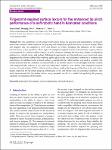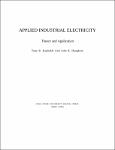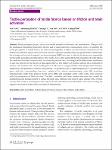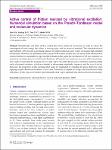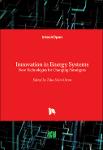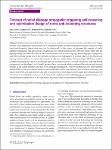Search
Author
- Amir, Ebrahimi (2)
- Aydin, Azizi (2)
- George, Haller (2)
- James, M. Fiore (2)
- next >
Subject
- Engineering (4)
- công nghệ (3)
- kỹ thuật (3)
- Robotics (3)
- next >
Date issued
Has File(s)
- true (215)
Search Results
The core capabilities of soft grippers/soft robotic hands are grasping and manipulation. At present, most related research often improves the grasping and manipulation performance by structural design. When soft grippers rely on compressive force and friction to achieve grasping, the influence of the surface microstructure is also significant. Three types of fingerprint-inspired textures with relatively regular patterns were prepared on a silicone rubber surface via mold casting by imitating the three basic shapes of fingerprint patterns (i.e., whorls, loops, and arches). Tribological experiments and tip pinch tests were performed using fingerprint-like silicone rubber films rubbing against glass in dry and lubricated conditions to examine their performance. |
Overview: This free electrical engineering/technology textbook provides a series of chapters covering electricity and electronics. The information provided is great for students, makers, and professionals who are looking for an application-centric coverage of this field. |
Tactile perception plays a critical role in the interaction of humans and environment. It begins with the mechanical stimulation induced by friction and is processed in the somatosensory cortex. To quantify the tactile perceptions of textile fabrics, the mechanical properties of fabrics and the features extracted from the friction and vibration signals were correlated with the subjective sensation rated by questionnaires. Meanwhile, the technique of functional magnetic resonance imaging (fMRI) was used to identify the brain areas responsible for the tactile perception of textile fabrics. |
Herein, a porous oil-containing material with hierarchical pore structure was successfully prepared through microtexturing large pores on the surface of porous polyimide (PPI) with single-level small pores. Compared to the conventional oil-containing material, the hierarchically porous oil-containing material exhibited high oil-content, and retained excellent mechanical properties and high oil-retention because of the synergistic effects of large pores and small pores. Furthermore, the lubricant stored in the hierarchically porous polyimide could release to the interface under thermal-and-mechano-stimuli, and the released lubricant could be reabsorbed into the hierarchically porous polyimide via the capillary-force offered by the porous channel. Based on the high oil-content and rec... |
Superlubricity and active friction control have been extensively researched in order to reduce the consumption of fossil energy, the failure of moving parts, and the waste of materials. The vibration-induced superlubricity (VIS) presents a promising solution for friction reduction since it does not require high-standard environment. However, the mechanism underlying the VIS remains unclear since the atomic-scale information in a buried interface is unavailable to experimental methods. In this paper, the mechanism of VIS was examined via numerical calculation based on the Prandtl—Tomlinson (PT) model and molecular dynamics (MD) simulations. The results revealed that the pushing effect of stick—slip is one of the direct sources of friction reduction ability under vibrational excitatio... |
Osteoarthritis is associated with the significantly increased friction of the joint, which results in progressive and irreversible damage to the articular cartilage. A synergistic therapy integrating lubrication enhancement and drug delivery is recently proposed for the treatment of early-stage osteoarthritis. In the present study, bioinspired by the self-adhesion performance of mussels and super-lubrication property of articular cartilages, a biomimetic self-adhesive dopamine methacrylamide—poly(2-methacryloyloxyethyl phosphorylcholine) (DMA—MPC) copolymer was designed and synthesized via free radical polymerization. |
This book aims to cover new technologies, methods, and approaches developed to meet: Traditional power systems are analog, unilateral, and mostly passive. New age power networks are smart, digital, incorporate communication for better operation, and involve collaborative decision-making. |
Self-loosening of bolted joints can occur in a vibration environment, and it may induce bolt fatigue fracture with catastrophic consequences. It is essential to clarify the self-loosening mechanism, based on which novel anti-loosening thread structures can be developed. In this paper, we propose the concept of radial slippage propagation and provide new insights into the self-loosening process. The new theory states that the slippage along the radial direction of the thread surface induces more slippage areas (slippage propagation), and self-loosening occurs due to the dynamic evolution and propagation of contact states on the thread and bearing surfaces with an increase in the number of vibration cycles. |
Introduction to engineering mechanics: statics, for those who love to learn. Concepts include: particles and rigid body equilibrium equations, distributed loads, shear and moment diagrams, trusses, method of joints and sections, & inertia. |
This book’s content should prepare you for subsequent classes covering Engineering Mechanics: Dynamics and Mechanics of Materials. At its core, Engineering Statics provides the tools to solve static equilibrium problems for rigid bodies. The additional topics of resolving internal loads in rigid bodies and computing area moments of inertia are also included as stepping stones for later courses. We have endeavored to write in an approachable style and provide many questions, examples, and interactives for you to engage with and learn from. |

